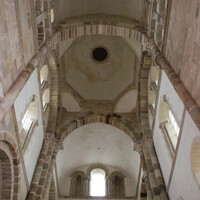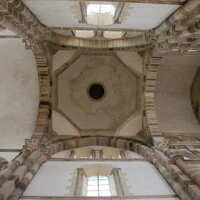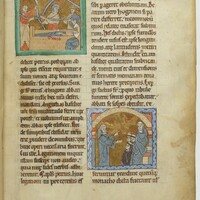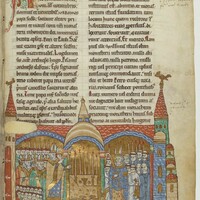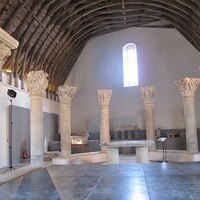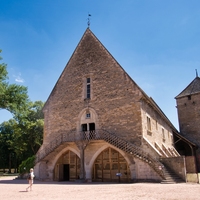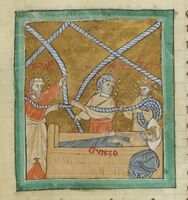Cluny III
Date:
1088 to 1130
Location or Findspot (Modern-Day Country):
France
Description:
A Benedictine abbey was founded at Cluny in 910 with a modest church (known as Cluny I). As the monastery increased in wealth and prestige, attracting larger numbers of monks, its church was rebuilt in 981 (Cluny II) and again between 1088 and 1130. This last church, the five-aisled Cluny III, was the largest building in Europe.
The monastery was dedicated to saints Peter and Paul and subject only to the pope. At its height the motherhouse of Cluny had over 1000 daughter houses, but despite enormous donations of gold from rulers in England and Spain (the latter funds seized from the Muslims), the ambitious abbots nearly bankrupted the monastery with this final building campaign. Bernard of Clairvaux (1090–1153) was very critical of such extravagance and founded a new Benedictine order, the Cistercians, to counter the excesses of Cluny.
Cluny emphasized participation in the liturgy, not manual labor, as the monks' main responsibility. The monks also commissioned and produced works of art to enhance the liturgy. A late twelfth-century collection of Cluniac historical and liturgical documents (Bibliothèque national de France, MS lat. 17716) illustrates the supposed motivation for building Cluny III. On the upper left of fol. 43r, saints Paul, Peter, and Stephen appeared to a paralyzed monk named Gunzo to convey their desire for a new church. They urge Gunzo to memorize its dimensions, which they lay out with ropes—the normal medieval construction method. Gunzo is to tell the abbot, Hugh, that he too will become paralyzed if he does not carry out the saints' wishes. In the second miniature on the page, Gunzo, already cured of his paralysis, makes his case to Abbot Hugh. Fol. 91r of the manuscript shows the consecration of the main altar of the new church by Pope Urban II and Abbot Hugh in 1095.
Only the south transept remains of Cluny III, which after the French Revolution was largely demolished and used as a quarry. In addition, eight capitals carved ca. 1100 are preserved from the choir. Two of them depict musicians who personify the tones or modes of Gregorian chant, as indicated by Latin inscriptions. The figures demonstrate how to learn music as a pathway to devotion; by achieving inner harmony, the monks could hope to imitate heavenly song collectively. The capitals are now displayed in a thirteenth-century building originally used to store the monastery's flour (now the Musée Farinier).
The Musée de Cluny in Paris, which displays medieval art, was formerly the townhouse of Cluny's abbots.
The monastery was dedicated to saints Peter and Paul and subject only to the pope. At its height the motherhouse of Cluny had over 1000 daughter houses, but despite enormous donations of gold from rulers in England and Spain (the latter funds seized from the Muslims), the ambitious abbots nearly bankrupted the monastery with this final building campaign. Bernard of Clairvaux (1090–1153) was very critical of such extravagance and founded a new Benedictine order, the Cistercians, to counter the excesses of Cluny.
Cluny emphasized participation in the liturgy, not manual labor, as the monks' main responsibility. The monks also commissioned and produced works of art to enhance the liturgy. A late twelfth-century collection of Cluniac historical and liturgical documents (Bibliothèque national de France, MS lat. 17716) illustrates the supposed motivation for building Cluny III. On the upper left of fol. 43r, saints Paul, Peter, and Stephen appeared to a paralyzed monk named Gunzo to convey their desire for a new church. They urge Gunzo to memorize its dimensions, which they lay out with ropes—the normal medieval construction method. Gunzo is to tell the abbot, Hugh, that he too will become paralyzed if he does not carry out the saints' wishes. In the second miniature on the page, Gunzo, already cured of his paralysis, makes his case to Abbot Hugh. Fol. 91r of the manuscript shows the consecration of the main altar of the new church by Pope Urban II and Abbot Hugh in 1095.
Only the south transept remains of Cluny III, which after the French Revolution was largely demolished and used as a quarry. In addition, eight capitals carved ca. 1100 are preserved from the choir. Two of them depict musicians who personify the tones or modes of Gregorian chant, as indicated by Latin inscriptions. The figures demonstrate how to learn music as a pathway to devotion; by achieving inner harmony, the monks could hope to imitate heavenly song collectively. The capitals are now displayed in a thirteenth-century building originally used to store the monastery's flour (now the Musée Farinier).
The Musée de Cluny in Paris, which displays medieval art, was formerly the townhouse of Cluny's abbots.
Relevant Textbook Chapter(s):
7,
8
Repository and Online Resources:
• Read more about Cluny on the Khan Academy website.
• See more images of Cluny's thirteenth-century farinier (flour building) on the Structurae website.
Image Credits:
Wikimedia Commons; Flickr; Structurae




